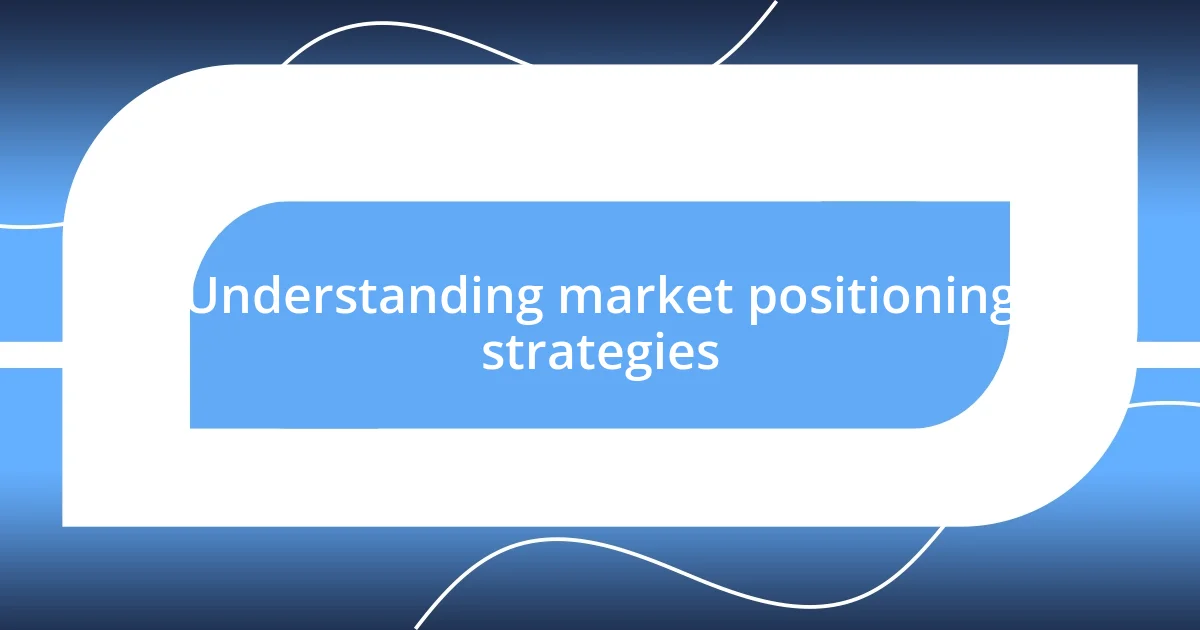Key takeaways:
- Understanding customer needs through surveys, empathy, and social listening is crucial for effective market positioning.
- Crafting a unique value proposition requires simplicity and emotional connection, focusing on how products positively impact customers’ lives.
- Utilizing data analytics and measuring success through engagement metrics, conversion rates, and customer feedback significantly enhances positioning strategies.

Understanding market positioning strategies
When I think about market positioning strategies, I often reflect on my own experiences trying to carve a niche for my brand. It’s fascinating how understanding your target audience can really inform your positioning. Have you ever considered what your customers truly value? For me, it was eye-opening to realize that aligning my product’s features with their desires made a significant impact.
One strategy that resonates with me is differentiation. I remember a time when I struggled to stand out in a saturated market, but emphasizing unique qualities of my offerings, like sustainability or local sourcing, made all the difference. This approach not only attracted customers but also fostered loyalty because they connected with my brand’s mission. Can you recall a time when a brand’s unique positioning caught your attention? That emotional connection is what truly solidifies a positioning strategy.
Another key insight is the importance of clarity in messaging. In my journey, I found that simplifying communication about my brand’s value proposition helped potential customers quickly grasp what I stood for. It’s true that if they can’t understand your message at a glance, they might just move on. How often do we scroll past ads that don’t resonate with us? Crafting a clear and compelling message can turn that scroll into a pause, making your brand unforgettable.

Identifying target audience needs
Identifying the needs of your target audience is crucial for effective market positioning. I remember when I first started to dive deep into understanding my audience. I conducted surveys and interviews, which revealed insights that I hadn’t even considered. Not only did this help in aligning my products with customer desires, but it also sparked conversations that led to new ideas for improvement. Have you ever discovered something surprising about what your customers really want? Those revelations can shape your entire strategy.
Another aspect that I learned is the power of empathy. Stepping into the shoes of my customers helped me anticipate their needs and frustrations. I recall a particularly enlightening day when I spent time in a store, watching how potential customers interacted with my products. Observing their reactions gave me a wealth of information that surveys alone could not uncover. It’s amazing how a little observation can provide clarity on what your audience truly values.
Incorporating social listening has also proven invaluable in this process. By monitoring conversations on social media and online forums, I glean insights into trends and preferences that might not surface in traditional research. I often discover common themes in how customers describe their pain points and desires. Engaging with them in this space creates a dialogue that not only enhances my understanding but also fosters a sense of community around my brand. Isn’t it incredible how technology can bridge the gap between businesses and consumers?
| Method | Description |
|---|---|
| Surveys | Gather direct feedback from customers to understand their preferences and needs. |
| Empathy Exercises | Gain insights by experiencing the customer journey firsthand. |
| Social Listening | Monitor online conversations to identify trends and sentiments related to your brand. |

Analyzing competitors’ positioning tactics
My journey in analyzing my competitors’ positioning tactics has been nothing short of enlightening. One significant lesson was tuning in to how they communicate their unique selling propositions. I spent time examining their marketing materials, social media posts, and customer interactions. Each detail revealed their strategies and how they connect with their audience. Notably, when I noticed how some brands use scarcity in their messaging to create urgency, it inspired me to rethink how I present my limited-time offers. It’s about recognizing what resonates and adapting it to my narrative while staying true to my values.
Here are some key elements I focus on when analyzing competitors’ tactics:
- Messaging Clarity: How clearly do they convey their value proposition? Is it instantly recognizable?
- Emotional Engagement: Do they evoke feelings that resonate with their audience, such as nostalgia or excitement?
- Visual Identity: What role does design play in their brand recognition? Are their visuals distinct and memorable?
- Connection with Audience: How actively do they engage with their customers across different platforms?
- Innovation: Are they introducing new features or services that differentiate them from the rest?
I find that every insight gleaned from competitor analysis serves as a beacon for my positioning strategies, guiding me toward a more impactful connection with my own audience.

Crafting a unique value proposition
Crafting a unique value proposition is about distinguishing yourself in a crowded market. I remember when I first attempted to define my own proposition; it felt like trying to find a needle in a haystack. I spent late nights brainstorming what set my brand apart. It struck me that it wasn’t just about my product features but the deeper emotional connection that I could create with my customers. Have you ever wondered what truly makes your offering special?
One method that proved vital in this process was focusing on customer emotions. For instance, I conducted interviews where customers shared how my product positively impacted their lives. Hearing their stories truly opened my eyes to the value they found in my work. It wasn’t about the product features anymore; it was about how those features alleviated pain points and improved their experiences. Have you thought about the stories behind your customers’ purchases?
Another key insight was the importance of a clear and compelling message. I distinctly recall refining my value proposition after a brainstorming session with my team. We focused on delivering our message in a few short sentences that encapsulated our essence. This clarity not only helped our audience understand us better but also enabled us to convey our passion and mission more effectively. I learned that simplicity often speaks louder than complexity. So, what does your messaging say about you?

Leveraging brand storytelling effectively
Leveraging brand storytelling effectively has been a transformative journey for me. When I first began weaving narratives into my marketing efforts, I didn’t realize the profound impact it would have on my audience’s connection with my brand. I vividly recall crafting a story around my initial struggles as an entrepreneur. It resonated deeply with my customers, as they often saw reflections of their own challenges in my narrative. Have you ever thought about how your personal story might unlock an emotional bond with your audience?
One powerful technique I adopted was to incorporate authentic customer experiences into my storytelling. I remember featuring a loyal client’s journey in a blog post, detailing how my product had changed their life. Not only did this create a sense of community, but it also reinforced trust in my brand. Storytelling isn’t just marketing; it’s an invitation for your customers to be part of your narrative. Do you invite your audience to share their stories with you?
Finally, I realized that compelling visuals can amplify storytelling. A well-designed graphic or video can evoke emotions that words alone may not convey. I once collaborated with a videographer to create a mini-documentary about my brand’s inception. Seeing my early days on the screen not only inspired my team but also strengthened the emotional ties with our audience. It vividly illustrated our mission and values. How do you visually articulate your brand’s journey?

Utilizing data for informed decisions
Utilizing data for informed decisions has been a game-changer in my approach to market positioning. I still vividly recall the first time I dove into analytics; it was like opening a treasure chest filled with insights about my audience. By examining customer behavior through metrics, I uncovered preferences and trends that I hadn’t even considered before. Have you ever experienced that ‘aha!’ moment when data reveals something unexpected about your customers?
Another experience that stands out is my use of A/B testing. When I redesigned my website, I wasn’t sure which call-to-action would resonate more with my audience. So, I created two versions and analyzed the engagement rates. The results were eye-opening. I learned that a straightforward approach led to higher conversions than I initially thought possible. This shift in understanding allowed me to optimize not just the website but also my overall marketing strategy. Have you explored the power of A/B testing in your own campaigns?
Moreover, I’ve started integrating social listening tools into my strategy. They provide an abundance of data about what people are saying online. I remember coming across a conversation about a common pain point in my industry; it sparked an idea for a product that perfectly addressed that need. By tuning into these discussions, I’ve been able to make decisions that resonate directly with my audience. What insights could you glean by simply listening to your customers?

Measuring success in market positioning
Measuring success in market positioning involves analyzing various metrics that reveal how well my brand resonates with its target audience. I once launched a campaign that aimed to rebrand my company; watching the engagement metrics soar was exhilarating. Each like and share felt like a validation of my efforts. Have you ever checked your metrics after a campaign and felt that rush of excitement when the numbers align with your vision?
Conversion rates are another critical indicator. During a recent product launch, I tracked not just sales but also the path customers took to reach the purchase. I discovered that personalized emails significantly boosted sales. It made me rethink my entire outreach strategy. Have you noticed how small changes can drive significant results in your campaigns?
Customer feedback, both qualitative and quantitative, also plays a vital role in my measurement process. I remember sending out a survey after a marketing push and was surprised by the level of engagement—people genuinely wanted to share their thoughts. Their insights helped me fine-tune my positioning even further. How do you gather feedback from your audience, and how does it shape your positioning strategy?












